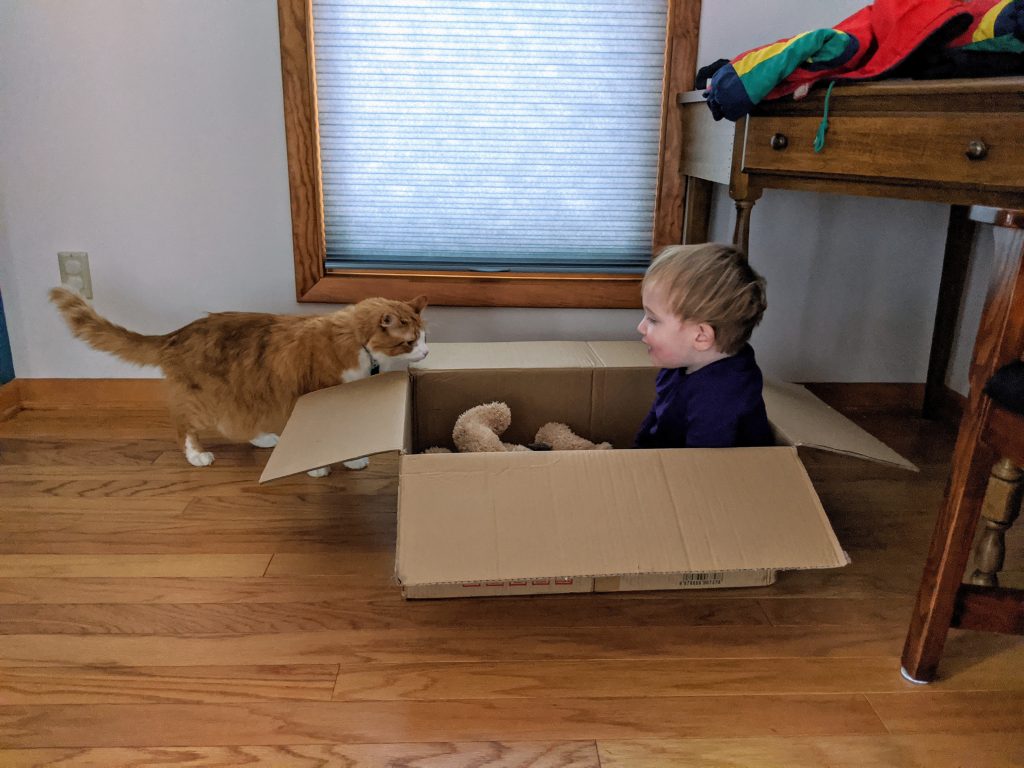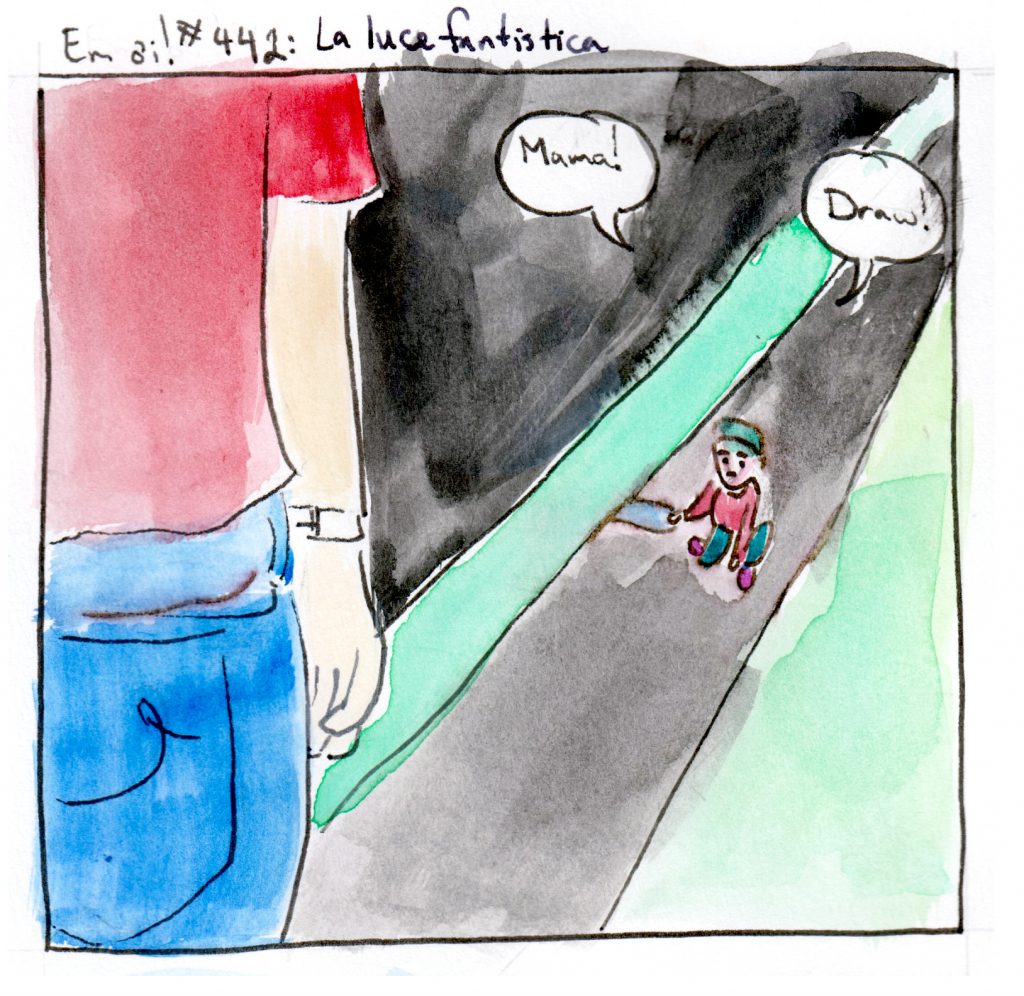
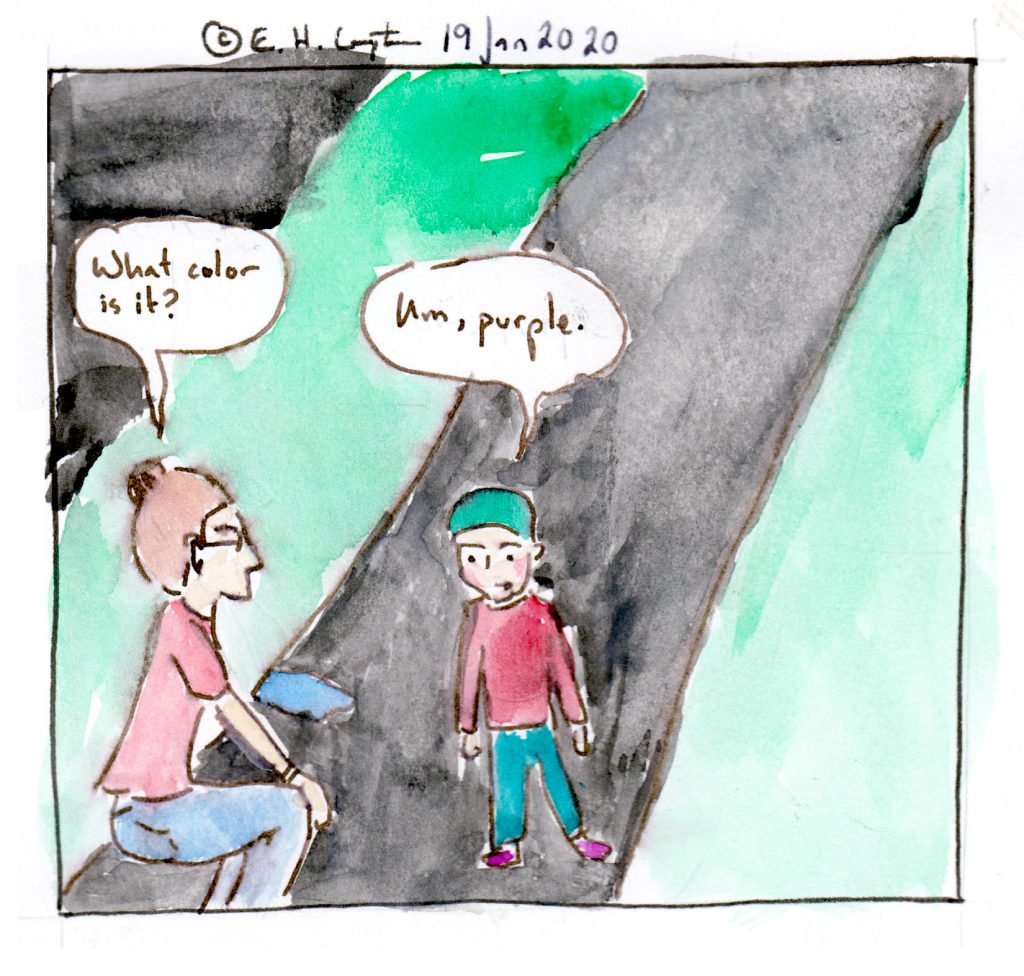
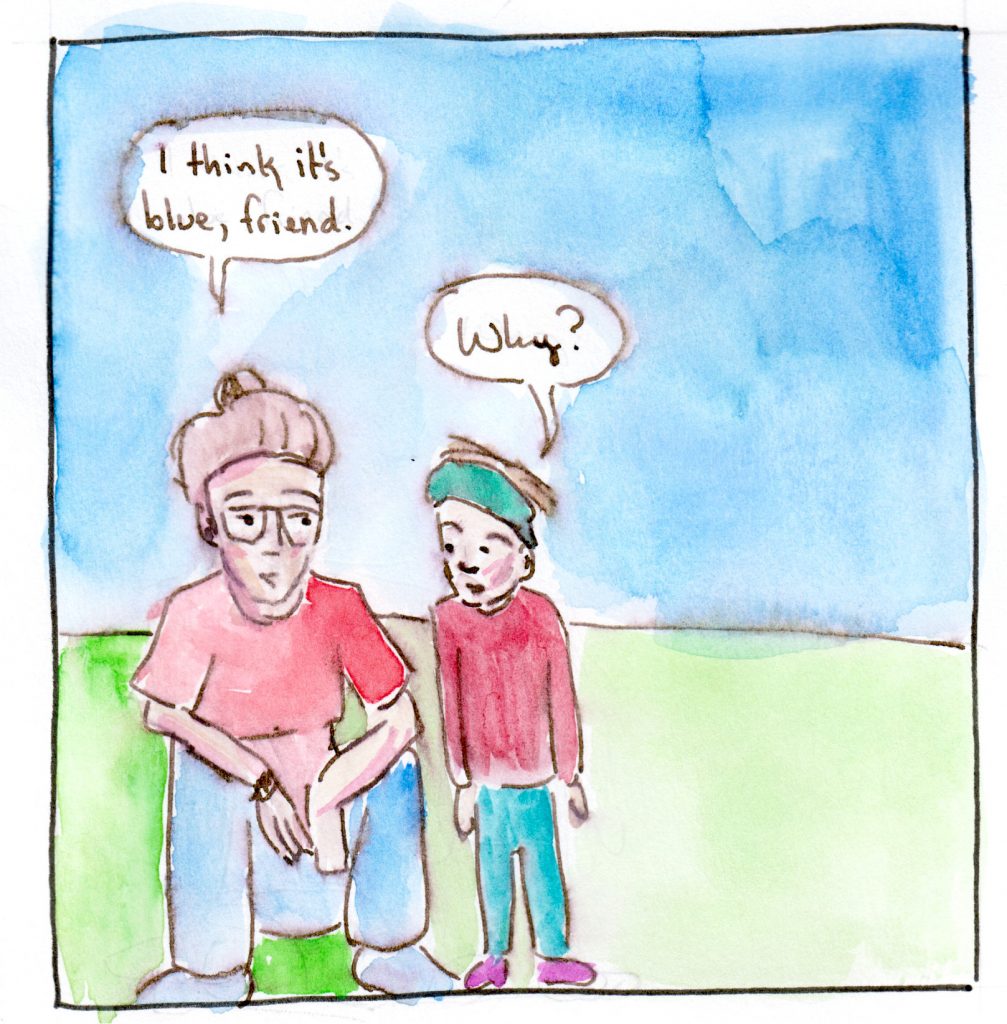
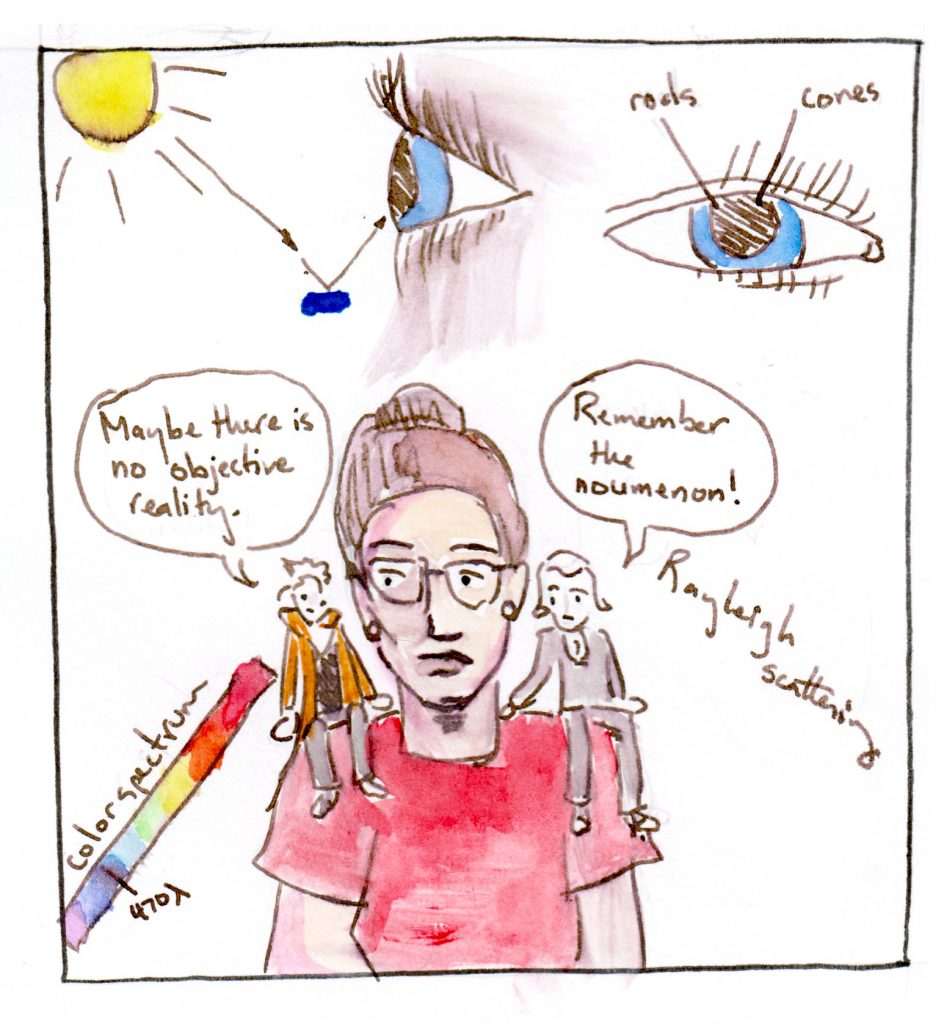
I started this one long enough ago that, among other things, Hal still apparently was speaking in one-word sentences and didn’t get colors right all the time. But when I finally finished it, I updated the drawing to look like he looks now, because small children are super hard to draw (the proportions are very different from adults).
The other thing that happened was I inked this comic with a fountain pen (my fine-tipped markers are in need of replacement) and it turns out the ink it was filled with (Pilot Iroshizuku Yama-guri, which I think means “wild chestnut”) is not waterproof. I figured this out when I was halfway through the process of watercoloring the comic. So if you noticed the bleeding in some panels, that’s why.
I decided to try and draw my hair the way I often wear it, which is halfway between Gibson girl and bitchy librarian. The Gibson girl hairstyle (as far as I can tell, anyway) works really well with my normal curly mess, but it’s worn much higher/farther forward on the head than I’m used to, so I often wind up with it a bit low, forming what is closer to a typical librarian bun. I think I could have made a pretty good Edwardian though, had I been afforded the opportunity. Sigh. Born too late to be an Edwardian, too early to explore the stars, as the saying goes.
Okay, so there was an XKCD about this (actually he’s done quite a few about color), but just saying “how can you really know what someone else is seeing” doesn’t really touch on how weird color actually is. See, there are a couple of factors that influence what you see. First is the actual wavelength of the light that reaches your eye. Then there’s the way your rods and cones function. Finally, there’s the visual cortex, where everything gets interpreted (Oliver Sacks wrote a lot about how that piece can go wrong). But what this can all add up to is non-spectral colors–basically, when you see wavelengths of light that trigger both the red and blue cones in your eye, your brain knows the color you’re seeing is between those colors, but that it’s not green, because the light would trigger the green cones. So your brain kind of makes up purple. Super weird.
Anyway, let’s do some 2019 numbers to round out last year:
Books read: 18 (about 6,000 pages)
- All Systems Red, by Martha Wells. Delightful.
- Redshirts, by John Scalzi. Amusing without really being great. I…don’t get why so many people lost their shit over this.
- The Valedictorian of Being Dead: The True Story of Dying Ten Times to Live, by Heather Armstrong. Oh Heatherrrrrr….A little bit more science and a little bit less “just caring for my children makes me so anxious that I have to spend my time crawling into my closet and crying and also I cannot hold down a normal job because I am a bloggerrrrr” would have been nice. Since reading this I have learned that electroconvulsive therapy (which is not like One Flew Over the Cuckoo’s Nest) actually has relatively good results for long-term depression that is not responsive to drugs, and while Heather sort of implies that the experiment she was a part of is better or potentially the only available treatment, that’s really not the case. So I don’t know how to feel about this book. On the one hand she super went through something. On the other hand, her understanding of what she went through is different from mine. Also, I have a really hard time when people are like “I have a life that you would have killed for but I gave it up/walked away/whatever.” I’m glad it helped, at least.
- Artificial Condition, by Martha Wells. Still fun, although not quite as awesome as the first.
- Good Bones, by Maggie Smith. Claire said “she writes about motherhood without being…you know.” And she’s right.
- Dawn, by Octavia Butler. Soooooooo…. This was creepy.
- Oh Crap! Potty Training: Everything Modern Parents Need to Know to Do It Once and Do It Right, by Jamie Glowacki. (Me now in 2020 writing this list) did I really read this back in (checks) March? Arg.
- Anathem, by Neal Stephenson. This was awesome and I loved 90% of it so much that I can forgive the 10% that comprises the facts that this has almost no women and a sort of dubious love story. I don’t think I will ever say this about a 900-page book again but I wish it had been longer.
- Maybe You Should Talk to Someone: A Therapist, Her Therapist, and Our Lives Revealed, by Lori Gottlieb. Gosh, this book has a terrible title but it was a really engrossing read and it got me back to therapy, which really helped, so.
- Cribsheet: A Data-Driven Guide to Better, More Relaxed Parenting, from Birth to Preschool, by Emily Oster. There’s not a ton of data but what there is is reassuring for the choices I have made.
- Under the Banner of Heaven, by Jon Krakauer. I don’t know if I 100% buy the thesis that Mormonism is a violent religion but I definitely see them in a new and less fluffy light.
- ROAR: How to Match Your Food and Fitness to Your Unique Female Physiology for Optimum Performance, Great Health, and a Strong, Lean Body, by Stacy Sims. This book was so awful that I’ve been thinking about getting it from the library again to make sure it was as bad as I thought it was.
- Reaper Man, by Terry Pratchett (reread). Masterful.
- Babel-17, by Samuel R. Delaney. Fantastic. Delaney is a master. The pervasive sense of dread was difficult to deal with though.
- Rogue Protocol, by Martha Wells. Still charming.
- Starless, by Jacqueline Carey. The first 2/3rds were amazing and the last third should probably have been a second book in the same series.
- Nine Princes in Amber, by Roger Zelazny (and about half of the second in the series, The Guns of Avalon). Manly men doing manly things with swords.
- Exhalation: Stories, by Ted Chiang. What technology does to us. What we do to ourselves.
Poems published: 7 (plus one more accepted, thought it will be out by the time I finish this blog post)
Rejections: 35 (includes poetry and fiction)
Miles run: 2,323 (goal: 2,300; biggest month: May, with 215; smallest month: February, with 15); this breaks down into 79.92 mi on the elliptical, 165.92 on the dreadmill, 96.07 miles raced, 296.27 miles run as long runs, 832.63 stroller miles, and 820.61 “normal” (not otherwise categorized) miles
Fastest race: Labor Day Dash stroller 5k (25:38)–1st place
Slowest race: New Glarus Woods 10 miler (1:46:43)–11th in age group, 56th overall
Comics posted: 4 (yikes)
That’s all the numbers I have.
We’ll file the comic under B105.C455 L86 2020, for Philosophy (General)–Special topics, A-Z–Color. Special thanks to B for the title.
